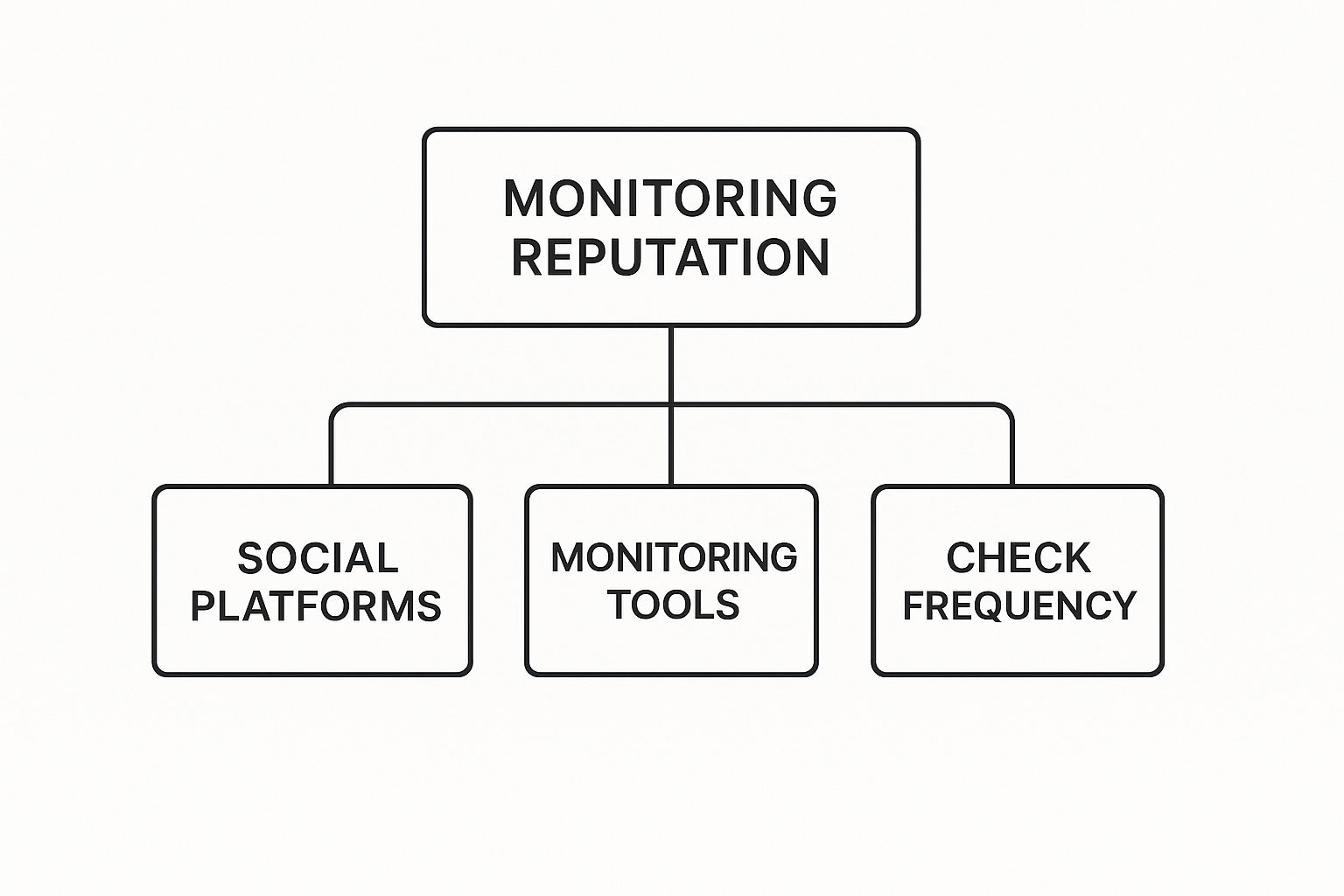Master Social Media and Online Reputation Management Today
Social media and online reputation management is all about keeping an eye on how your brand is seen on social networks and review sites, and actively shaping that perception. It's no longer optional; this is the first impression you make on nearly everyone who might consider buying from you.
Your Brand's Digital First Impression
Think of your online reputation as your brand's digital handshake. It’s the instant gut feeling someone gets when they search your name, a powerful first impression that happens long before they ever land on your website or talk to a salesperson.

This first impression is formed in the internet's bustling town square, where conversations about your business are happening 24/7. People are talking about your products, your service, and your customer care on platforms like Facebook, X, and Google Reviews—whether you're part of the conversation or not.
Ignoring these discussions is like leaving your storefront completely unattended. You miss out on priceless chances to connect with customers, clear up confusion, and turn curious onlookers into buyers.
Why Your Digital Handshake Matters
Getting proactive with social media and online reputation management isn’t just about putting out fires. It's about deliberately building trust and credibility, one interaction at a time. Every thoughtfully answered question or gracefully handled complaint adds to the story people tell about your brand. By jumping into these conversations, you can turn casual observers into your biggest fans.
This has become a core part of business strategy because opinions now spread at lightning speed. Today, over 75% of people check online reviews before they buy something, showing just how much these platforms steer purchase decisions.
The effect is even stronger with younger audiences. A staggering 91% of consumers aged 18 to 34 trust businesses more when they see positive reviews. Discover more insights on why reputation matters in 2025.
Your brand's reputation is built on a foundation of trust, consistency, and authentic engagement. It’s the sum of every comment, review, and interaction that potential customers see online.
This all points to one simple truth: what happens online directly hits your bottom line. A great reputation can boost sales and create fierce loyalty, while a neglected one can scare off even the most interested customers.
The Core Pillars of Reputation Management
At its heart, managing your online reputation comes down to a few key activities working together. These pillars are the foundation of a strong, resilient brand image.
Here's a simple breakdown of what that looks like:
| Pillar | Objective | Key Activities |
|---|---|---|
| Monitoring | To understand what is being said about your brand, competitors, and industry. | Tracking brand mentions, keywords, and sentiment across social media and review sites. |
| Engagement | To build relationships, foster community, and manage customer feedback. | Responding to comments, answering questions, and addressing both positive and negative reviews. |
| Content Creation | To shape the narrative and showcase brand expertise and values. | Publishing valuable content, sharing positive user-generated content, and building social proof. |
By mastering these areas, you can stop just reacting to problems and start proactively shaping how the world sees your brand. It’s about taking control of the conversation, one post at a time.
Mastering Proactive Reputation Management
Great social media and online reputation management isn't about playing defense—waiting for a crisis to hit and then scrambling to put out the fire. It's about getting ahead of the conversation and actively shaping your brand's story. This whole system really boils down to three core pillars: constantly Monitoring what's being said, creating authentic Engagement, and building a library of strategic Content.
Think of it like tending a garden. You have to constantly keep an eye out for weeds (Monitoring), give extra care to the plants that are already flourishing (Engagement), and strategically plant new flowers to make the whole landscape more beautiful (Content). If you let any one of those tasks slide, you're leaving your reputation up to chance.
When you nail this proactive approach, reputation management stops feeling like a chore and starts acting like a powerful engine for growth. You build real trust, earn loyalty, and create a brand image so strong it can easily shrug off the occasional negative comment.
The Art of Monitoring Your Digital Footprint
Before you can manage your reputation, you have to actually know what it is. Monitoring is all about becoming the ears of your brand, tuning into that massive digital chatter to catch every mention, keyword, and whisper about your business.
And this isn't just about looking for complaints. It's about getting the full picture of public sentiment. What do people absolutely love about your product? What little frustrations are simmering just below the surface? Who are your biggest fans, and who are your loudest critics?
A solid monitoring plan needs structure. You have to know which platforms to watch, have the right tools to listen effectively, and set a consistent schedule for checking in.
This hierarchy diagram shows the fundamental structure of a robust reputation monitoring plan.

As the visual makes clear, successful monitoring is a simple combination of knowing where to look, having the right tools to listen, and establishing a consistent cadence to keep your finger on the pulse.
Perfecting Your Engagement Strategy
Monitoring gives you the intel; engagement is what you do with it. Every single interaction—from glowing praise to sharp criticism—is a chance to make your reputation stronger. Considering a reported 94% of customers have actively avoided a business because of negative online reviews, you can see how much poor engagement can cost you.
Responding to Positive Feedback
When a customer leaves a positive comment, they're handing you a gift. How you respond can amplify that positivity for everyone else to see.
- Personalize Your Thanks: Ditch the generic "Thanks!" and mention something specific from their comment. It shows a real person is listening.
- Encourage Sharing: Ask if you can feature their kind words as a testimonial on your website or social media. Most people are happy to help.
- Invite Further Interaction: Keep the good vibes going by asking a follow-up question. This helps build a real sense of community.
Navigating Negative Comments
Negative feedback isn't a disaster. It's a golden opportunity to show everyone watching how much you care about getting things right.
- Respond Promptly and Publicly: Acknowledge the comment within 24 hours. This signals to everyone that you're paying attention and take feedback seriously.
- Empathize and Validate: Start by showing you understand their frustration. Simple phrases like, "I can see how frustrating that would be," work wonders to de-escalate tension.
- Take it Offline: Provide a direct way to connect—like an email or support number—to sort out the specific details privately. This protects their privacy and keeps a long, messy back-and-forth off your public page.
The goal isn't always to win back that one unhappy customer. It's to show every potential customer reading the exchange that you are a responsible, caring brand that shows up.
Building a Fortress with Strategic Content
The final pillar is all about creating a "reputational fortress" with smart content. This means you’re proactively publishing valuable, positive, and authoritative content that not only defines your brand but also naturally pushes any negative search results further down the page where no one will see them.
Think of your brand's Google results page as prime digital real estate. If you don't own the properties on that first page, someone else will. By consistently creating high-quality content, you can claim all that valuable space for yourself.
Your content strategy should be designed to:
- Showcase Expertise: Publish blog posts, white papers, and case studies that prove you know your stuff and build trust with your audience.
- Highlight Positive Stories: Share customer success stories, great reviews, and user-generated content. This kind of social proof is incredibly powerful.
- Communicate Brand Values: Create content that gives people a peek into your company culture and mission, helping you connect with your audience on a much deeper level.
By consistently executing on these three pillars—Monitoring, Engagement, and Content—you grab the reins of your brand's narrative. You stop being a passive subject of online chatter and become an active, respected voice in the conversation, building a rock-solid reputation that will become one of your greatest assets.
Building Your Social Listening Toolkit

To really get a handle on your reputation, you need the right tech. Think of social listening tools as your brand’s digital radar, constantly scanning the online world for signals that actually matter. This kind of technology gives you a full 360-degree view, helping you shift from a reactive, damage-control mindset to a proactive, data-informed strategy.
Modern social media and online reputation management is about more than just setting up a few keyword alerts. It’s about catching the feeling behind the words, spotting trends before they go mainstream, and flagging potential crises before they have a chance to blow up. The right toolkit is what separates the brands that just react from those that lead the conversation.
Core Features of a Modern Listening Tool
Picking a tool can feel like a chore, but the best platforms all share a few non-negotiable features. These are the engine of any solid reputation strategy, turning a firehose of raw data into insights you can actually use. Make sure any tool you consider excels in these areas.
- Real-Time Monitoring: The power to track mentions of your brand, your rivals, and key industry terms as they pop up across social media, blogs, and forums.
- Sentiment Analysis: AI that goes beyond simple keyword matching to figure out the emotional tone—positive, negative, or neutral—of any given conversation.
- Trend Identification: Smart algorithms that notice unusual spikes in chatter or shifts in sentiment, alerting you to topics that are gaining traction with your audience.
- Competitive Benchmarking: The ability to track your share of voice against your competitors, giving you a clear picture of where you stand in the market.
These features work in concert to give you a complete check-up on your brand's health. By seeing not just what people are saying but how they're saying it, you can respond with more precision and empathy.
Understanding AI-Powered Sentiment Analysis
One of the most powerful pieces of a modern toolkit is AI-powered sentiment analysis. Imagine trying to manually read thousands of comments to get a feel for the public mood—it’s just not possible. AI automates this by analyzing the language, context, and even the emojis in a post to assign a sentiment score.
This tech helps you instantly sort feedback into different buckets. A sudden nosedive in your brand’s sentiment score can be the first red flag of a product flaw or a service breakdown, letting you jump in and investigate before a small problem mushrooms into a full-blown crisis.
Sentiment analysis is like a brand EKG. A steady, positive rhythm indicates strong health, while a sudden, sharp dip is an early warning of trouble that requires immediate attention.
This capability is vital, especially when you consider the sheer speed and volume of online conversations. Social media's influence is massive, with consumers mentioning brands about 90 times a week. On top of that, a whopping 87% of shoppers do their homework online before buying anything. This behavior underscores why real-time monitoring and sentiment analysis are essential for catching feedback early and keeping trust intact.
Choosing the Right Tool for Your Business
The best tool for you really depends on your specific needs, team size, and budget. While some enterprise-level platforms offer incredible power, plenty of great tools are built for small to medium-sized businesses, striking a nice balance between key features and affordability.
When you're weighing your options, think about these factors:
- Platform Coverage: Does the tool keep an eye on the specific social networks and websites where your customers hang out?
- Alerting and Reporting: Can you set up custom alerts to get notified about critical issues right away? Are the reports easy to understand and share with your team?
- Integration Capabilities: Does it play nice with the other tools you already use, like Slack or your CRM, to make your response process smoother?
Platforms like Intently use advanced AI to turn social listening from a passive monitoring task into an active engine for lead generation and reputation management. By spotting conversations where buying intent is high, these tools help teams engage proactively instead of just listening. For a deeper dive, check out our guide on advanced social media reputation monitoring strategies.
Ultimately, your toolkit should empower you to not only listen but also to understand and act. Investing in the right technology gives you the clarity you need to protect your brand, connect with your audience, and build an online reputation that can weather any storm.
Navigating a Social Media Crisis with Confidence
In the world of social media, a single spark can ignite a wildfire in minutes. A negative comment blows up, sentiment plummets, and suddenly you’re in a full-blown crisis. It feels like a storm hitting out of nowhere, but a solid plan is your anchor in the chaos. When you panic, you make bad decisions. When you have a framework, you manage the situation with control and confidence.
But a good response isn't just about putting out the fire. It's a chance to prove you're listening, you care, and you’re committed to doing the right thing. Handle it well, and you can actually come out the other side with more customer trust, not less. You're showing your brand's true character when the pressure is on.
Assemble Your Rapid-Response Team
Before a crisis ever breaks, you absolutely have to know who's in charge. Scrambling to assign roles while the building is burning is a recipe for disaster. Your rapid-response team should be a small, cross-functional group empowered to act fast.
This isn’t a committee that needs to schedule a meeting for next Tuesday. It's a core group of stakeholders who can make decisions without getting tangled in red tape.
- Social Media Manager: This person is on the front lines, monitoring every mention and publishing the communications your team agrees on.
- Marketing/Communications Lead: They're in charge of crafting the message, making sure every word aligns with your brand's voice and values.
- Customer Support Lead: This person brings crucial context about the customer's actual problem and helps figure out a real solution.
- Legal Advisor (if needed): For sensitive situations, they’ll review public statements to make sure you aren't creating unnecessary legal risks.
The whole point is to have a clear chain of command. When an issue flares up, everyone already knows their job and can get to work immediately.
The Crisis Response Playbook
When negative sentiment starts spiking, your team needs a script—not to sound robotic, but to replace gut reactions with a strategic approach. This playbook ensures your response is measured, empathetic, and actually works.
- Acknowledge Promptly, Not Prematurely: Your first move is to show you're listening. A quick, simple public statement like, "We're aware of this situation and are looking into it. We'll share an update as soon as we have more information," is often perfect. It buys you time to figure out what’s going on without making promises you can't keep.
- Investigate Internally: Now, get all the facts. What actually happened? Who was affected? Is this a one-off issue or a symptom of a bigger problem? You can’t craft a real response until you know the whole story.
- Draft a Clear, Empathetic Statement: Your official response needs to sound like it was written by a human, not a legal department. If you messed up, apologize sincerely. Explain what happened without making excuses, and then clearly outline what you’re doing to fix it. Transparency is everything here.
A genuine apology has three parts: acknowledging the mistake, showing remorse for the impact it had, and explaining what you're doing to fix it. Anything less feels like a corporate non-apology and will only make the situation worse.
Know When to Take It Offline
Not every battle needs to be fought in the town square. Your initial acknowledgment should be public so everyone knows you're on it, but the back-and-forth of solving an individual's specific problem should move to a private channel like DMs or email.
This move accomplishes two critical things:
- It de-escalates the public drama, stopping a long, drawn-out argument that just attracts more negativity.
- It lets you give personalized help while protecting the customer’s private information. Handling personal data requires care; for more on user data management policies, you can find resources explaining how to request data deletion and manage privacy effectively.
A great public response often ends with an invitation to connect privately: "We are so sorry this happened. To help us resolve this for you immediately, could you please send us a DM with your contact details?" This shows everyone watching that you’re taking direct, personal action to solve the problem, which goes a long way in rebuilding trust.
Measuring the Health of Your Online Reputation
So, how do you know if all your hard work in social media and online reputation management is actually paying off? Without the right measurements, you're essentially flying blind, making decisions based on gut feelings instead of solid data. To get a real sense of where your brand stands, you have to look past simple vanity metrics like follower counts and dive into the numbers that show genuine brand health.

Tracking the right KPIs proves the real-world business impact of a strong online reputation. It shifts reputation management from a cost you just have to bear into a measurable driver of customer loyalty and sales, giving you a clear return on your investment.
Key Metrics That Truly Matter
To get an accurate pulse on your reputation, you need a balanced scorecard of metrics. These numbers should measure public perception, your competitive standing, and customer loyalty. Each KPI tells a different part of your brand’s story, and together they create a complete picture of your online health.
Here are the essential metrics you should be tracking:
- Sentiment Score: This metric is like your brand's EKG. It analyzes the emotional tone behind brand mentions—positive, negative, or neutral. A steady incline signals strong health, while a sudden dip is an early warning sign of trouble.
- Share of Voice (SoV): SoV measures how much your brand is being talked about online compared to your competitors. A growing SoV means your brand is becoming a more prominent voice in your industry’s conversation.
- Net Promoter Score (NPS): Usually gathered through surveys, NPS is a powerful predictor of future growth. It reflects customer loyalty by asking one simple question: how likely are they to recommend your brand?
These metrics offer a much deeper understanding than surface-level numbers. They don't just tell you if people are talking about you, but how they feel and where you stand in the market.
Understanding Your Sentiment Score
Your Sentiment Score is arguably the most direct measure of your online reputation. It's calculated as the ratio of positive mentions to negative ones over a specific time, giving you a clear snapshot of how the public feels. Think of it as the collective mood of the internet toward your brand.
This kind of advanced measurement is becoming fundamental to business success. The Sentiment Score helps you track your reputation's health far more effectively than just reacting to random daily fluctuations online. A consistently rising score signals that your brand perception is getting stronger, while sharp declines highlight issues that need your immediate attention. This is often paired with Engagement Rate (how connected you are with your audience) and Share of Voice (your market presence). You can learn more about how these metrics shape brand strategy on cleartailmarketing.com.
Monitoring your sentiment is like listening to the heartbeat of your brand. A healthy, stable rhythm is a sign of trust and satisfaction, whereas erratic spikes or drops demand an immediate diagnosis.
Turning Metrics into Actionable Insights
Data is only useful if it leads to action. Once you start tracking these KPIs, the goal is to connect them to tangible business outcomes and use them to sharpen your strategy.
For example:
- If your Sentiment Score drops: Dive into the negative mentions. Is there a recurring product complaint or a problem with customer service? Use this direct feedback to fix the root cause.
- If your Share of Voice is low: Take a look at your competitors' content. What are they doing to dominate the conversation? This insight can help you rework your content strategy to grab more visibility.
- If your NPS is stagnant: Look closely at the feedback from "Detractors." Their comments often hold the most valuable clues for improving your customer experience and turning them into promoters.
By consistently measuring these core KPIs, you turn reputation management from a reactive guessing game into a proactive, data-driven discipline that actively builds and protects your brand’s most valuable asset.
Common Questions About Reputation Management
Even with the best strategy, the world of social media and online reputation management can throw some curveballs. Let's tackle some of the most common questions that pop up for businesses, with real-world advice you can actually use.
How Can a Small Business Start with Limited Resources?
You don’t need a massive budget or an enterprise-level toolkit to make a real impact. For small businesses, it’s all about being smart and consistent with what you have.
Start by setting up Google Alerts for your business name, key products, and even your top executives. It's totally free and surprisingly powerful for keeping an eye on mentions across the web. Next, make sure you claim and fully deck out your Google Business Profile. This is often the first impression a customer gets.
Finally, just dedicate a small chunk of time each day—even 15-20 minutes is enough—to check your main social media channels for comments and messages. The goal isn't to be everywhere at once; it's to be fantastic on the one or two platforms where your customers actually hang out.
What Is the Best Way to Handle a Negative Online Review?
A negative review is a moment of truth. The key is to stay calm and strategic, showing everyone watching that you're transparent and willing to make things right. It's less about winning an argument and more about demonstrating character.
First, respond publicly and do it fast, ideally within 24 hours. Acknowledge their frustration right away and thank them for the feedback. This simple step shows you value their opinion, even when it’s critical.
Keep your public reply professional, polite, and to the point. Never, ever get into a back-and-forth argument or spill private details. Instead, offer to take the conversation offline to solve the problem. Give them a direct contact, like a support email or phone number. This move alone shows every future customer that you’re committed to service.
A great response turns a public complaint into a public display of your company's character. It tells future customers, "Even when things go wrong, we show up to fix it."
Once you've sorted things out privately, you can ask the customer to update their review, but that’s a bonus. The real win is demonstrating your accountability to the hundreds of other potential customers reading the exchange.
How Is Reputation Management Different from SEO?
This is a big one. While Online Reputation Management (ORM) and Search Engine Optimization (SEO) often feel connected and even use some of the same tactics, they have very different primary goals. Getting this distinction right is key to a solid digital strategy.
SEO is all about visibility. Its main job is to get a specific website or page to rank higher in search results for certain keywords. The end goal? Drive more organic traffic.
ORM, on the other hand, is about perception. It's a much broader mission focused on shaping and controlling how a brand or person is seen online. This includes:
- Social media monitoring to see what people are saying.
- Review management on sites like Google, Yelp, and others.
- Crisis response to handle negative events before they spiral.
- Proactive content creation to build a positive story around your brand.
Think of it like this: SEO gets people to your front door. ORM makes sure what they see when they look inside is positive. ORM often uses SEO tactics—like creating positive content that outranks negative search results—but its scope is much wider. In short, SEO is about visibility, while ORM is about perception. To see more on how these two work hand-in-hand, check out the articles on the Intently blog.
Can I Just Delete Negative Comments?
It's tempting, but deleting negative comments on your social media pages is almost always a terrible idea. It’s like trying to put out a small fire with gasoline.
When you remove criticism, you risk infuriating the person who posted it. They might then take their complaint to other platforms, adding "and then they deleted my comment!" to their story. This makes your brand look defensive and dishonest, like you have something to hide. It chips away at the trust you've worked hard to build.
Frankly, a squeaky-clean comment section with zero criticism just feels fake and can make customers suspicious.
The only time it's okay to hit delete is for comments that clearly violate your community guidelines. You absolutely should remove content that includes:
- Hate speech or personal attacks
- Spam or sketchy promotional links
- Someone's private or confidential information
For any other legitimate complaint, it's far better to address it head-on with a helpful, professional response. This approach shows you're transparent and truly care about your customers, which builds way more credibility than a sanitized comment section ever could.
Ready to stop guessing and start knowing what customers are saying about you? Intently uses AI-powered social listening to monitor conversations across X, Reddit, and LinkedIn, delivering high-intent leads and critical brand insights directly to you. Take control of your online reputation and turn social chatter into business growth. Learn more and get started at https://intently.ai.
